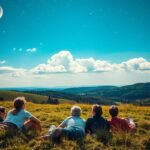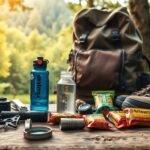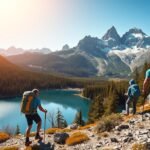Now Reading: Discover the Hidden World of Ground-Level Exploration
-
01
Discover the Hidden World of Ground-Level Exploration
Discover the Hidden World of Ground-Level Exploration

Discover the Hidden World of Ground-Level Exploration
Imagine being surrounded by nature and the sounds of the outdoors. Ground-level exploration lets you see things you might miss otherwise. It’s a chance to slow down and notice the small details.
There’s a lot to discover, from insects to wildflowers. Hobbies like fossil hunting and photography help us connect with nature. They make us appreciate the world around us.

Exploring the world helps us see its beauty and complexity. This article will show you how to explore nature through different hobbies. You’ll learn about new ways to enjoy the outdoors.
Key Takeaways
- Discover the fascinating world of ground-level exploration
- Learn about various hobbies associated with nature exploration
- Understand the benefits of engaging with the natural world
- Explore the unique perspectives offered by ground-level exploration
- Find inspiration for new outdoor activities and hobbies
The Overlooked Perspective: What Lies Beneath Our Feet
The ground beneath us is full of life and secrets. Looking at the world from the ground up is both interesting and educational.
The Richness of Ground-Level Ecosystems
Ground-level ecosystems are full of different plants and animals. They are key to keeping our environment balanced.
| Ecosystem Component | Role in Ecosystem |
|---|---|
| Microorganisms | Decomposition, Nutrient Cycling |
| Insects | Pollination, Decomposition |
| Plant Roots | Soil Stabilization, Nutrient Uptake |
Why Most People Miss What’s Below
Ground-level ecosystems are often ignored because we focus on what’s above. Nature observation from the ground can show us a lot about our environment’s health.
Get Outside Look Down: A New Approach to Nature Exploration
Exploring the world at our feet is a new way to enjoy outdoor adventure and nature discovery. It invites us to see the hidden beauty around us.
Defining Ground-Level Observation
Ground-level observation means looking closely at the world right under our feet. It’s a change from looking up to a more detailed, ground-focused view. This way, we find special things that we might miss otherwise.
Historical Context of Nature Observation
Nature observation has a long history, starting with early naturalists. They documented their findings, including the ground. Today’s “get outside look down” method builds on this, making it fresh for today’s explorers.
Modern Approaches to Ground Exploration
Now, exploring the ground uses many techniques and tools. From citizen science to advanced cameras, it’s easier than ever to discover nature. By using old and new methods, we can make our outdoor adventures even better.
Essential Equipment for Ground-Level Discovery
Exploring the ground requires the right tools to find hidden treasures. Whether you love nature or are just starting, the right gear makes a big difference. It boosts your ground view experience.
Basic Tools Every Explorer Needs
Every explorer should have a few basic tools. A good magnifying glass or hand lens is key for looking at small details. A field guide for your area helps identify plants and animals.
Also, a strong notebook and pencil are great for writing down what you see. They help you keep track of your discoveries.
Specialized Equipment for Different Activities
For specific interests, you might need special tools. For insect observation, a bug catcher or entomological net is helpful. For fossil hunting, a geologist’s hammer and hand lens are key.
For mushroom foraging, a basket and a fungi field guide are must-haves. These tools make exploring more fun and effective.
Budget-Friendly Options for Beginners
Starting your exploration hobby doesn’t have to cost a lot. Affordable options include a simple magnifying glass and many free field guides online. Even a smartphone can be useful with plant and animal apps.
For a bit more investment, a beginner’s kit for an activity like bug catching is a smart choice. The right tools make your outdoor activities better and deepen your nature connection. Whether in your backyard or the wilderness, the right gear boosts your explore outdoors experience.
Getting Started: Preparing for Your First Ground-Level Adventure
To enjoy your first ground-level adventure, pick the right spot and get ready for the outdoors. Nature observation is key, helping you connect with nature.
Choosing the Right Location
Finding the right spot is crucial for a great outdoor exploration. Look for places with different environments, like forests, meadows, or near water. These areas offer many things to see.
Weather and Timing Considerations
Weather conditions greatly affect your outdoor adventure. Always check the forecast and go when the weather is best. Early morning or late afternoon is perfect for seeing wildlife.
Safety Precautions for Outdoor Exploration
Safety is always first when exploring the outdoors. Wear the right clothes, carry essentials like water and a first-aid kit, and tell someone where you’re going. Being ready ensures a safe and fun nature observation trip.
Fossil Hunting: Uncovering Ancient Treasures
Fossil hunting is a thrilling way to explore nature. It gives you a close-up look at Earth’s past. This hobby mixes adventure with the excitement of finding ancient life’s leftovers.
Identifying Potential Fossil Sites
Starting your fossil hunt means finding the right spots. Look for places with exposed rock, like riverbanks and cliffs. Also, areas known for their ancient history, like the Badlands, are great places to search.
Step-by-Step Techniques for Responsible Collection
Collecting fossils the right way is key. Here’s how:
- Get any needed permits before you start.
- Take fossils out carefully to avoid breaking them.
- Write down where and how you found it.
- Make sure to leave the site as you found it.
Common Fossil Types for Beginners
Starters often find ammonites and trilobites. These are common and can be found worldwide.
How to Clean and Preserve Your Finds
After finding a fossil, clean and preserve it right. Start by brushing off dirt. If needed, use consolidants to stabilize it. Store it in a cool, dry spot. For very delicate fossils, you might need a pro’s help.
| Fossil Type | Common Locations | Preservation Tips |
|---|---|---|
| Ammonites | Europe, North America | Store in a dry environment to prevent pyrite decay. |
| Trilobites | North America, Morocco | Handle with care to avoid damaging the exoskeleton. |
| Leaf Impressions | Various global locations | Keep away from direct sunlight to prevent fading. |
Mushroom Foraging: A Delicious Ground-Level Pursuit
## Mushroom Foraging: A Delicious Ground-Level Pursuit
### Safety First: Identification Fundamentals
When you start mushroom foraging, safety is key. Learning how to identify mushrooms is crucial. With so many species, some safe to eat, some not, it’s easy to get confused. But, knowing the signs of the mushrooms you want can help avoid mistakes.
### Seasonal Foraging Calendar
Mushroom hunting changes with the seasons. Knowing when to look for certain mushrooms is important. For example, morels show up in spring, and chanterelles in late summer. Knowing your local climate and where mushrooms grow helps plan your hunts.
### Ethical Harvesting Practices
Good foraging is more than just picking mushrooms. It’s about caring for the environment and the mushrooms. Always take only what you need, so the species can keep growing. Also, check local laws on picking wild mushrooms, as some are protected.
#### Common Mistakes to Avoid When Foraging
1. Misidentification: The biggest risk is picking the wrong mushroom. Make sure you know what you’re picking.
2. Over-harvesting: Don’t take too many, as it can hurt the ecosystem.
3. Ignoring Local Regulations: Know the laws about picking wild mushrooms to avoid trouble.
By knowing these common mistakes, you can have a safe and fun time foraging for mushrooms. Happy foraging!

Insect Observation: The Tiny World of Arthropods
## Insect Observation: The Tiny World of Arthropods
Watching insects can be really interesting. It lets us see the small world of arthropods around us. By keeping insect observation journals, we can record our findings. This helps us understand the insects we see better.
### Creating Insect Observation Journals
First, get a notebook or journal for your insect observations. It helps you track the different species you find. You can also note their behaviors and look for patterns over time. Use a format with the date, location, and a description of the insects you see.
### Photography Techniques for Small Subjects
For taking pictures of insects, some techniques are key. Macro photography is essential for seeing their details. Use a macro lens or extension tubes to get close. Also, a tripod helps keep your camera steady, which is important for clear photos.
For very small or scared insects, use a remote shutter release or self-timer. This helps you not scare them away.
### Understanding Insect Behavior Patterns
Insects have complex behaviors. These are influenced by things like the environment, predators, and social interactions. By watching these behaviors, you can learn about the insects’ ecology and biology. For example, some insects live alone, while others live in groups with complex social structures.
#### Building Simple Observation Tools
To help with your observations, make or get simple tools. A sweep net or pitfall trap can be useful for catching and observing insects. For more specific observations, you might need a malaise trap or insect aspirator. These tools make it easier to collect and identify insects.
By following these tips, you can improve your insect observation skills. You’ll appreciate the tiny world of arthropods more. Happy observing!
Wildflower Photography and Identification
Wildflower photography and identification are great for those who love the outdoors. They mix art and science, letting you see wildflowers up close. You also learn more about nature.
Composition Tips for Ground-Level Shots
When you take pictures of wildflowers, how you compose them matters a lot. Get down to the flower’s level and try different angles. This makes your photos more interesting.
Use the rule of thirds to make your photos balanced. Add interesting backgrounds or foregrounds to make them deeper.
Lighting Considerations for Flower Photography
Lighting is crucial for wildflower photos. Soft, natural light makes colors and textures pop. The best times to take photos are early morning or late afternoon.
These times have softer, less harsh light than the midday sun.
Seasonal Wildflower Guide for the United States
Wildflowers bloom at different times in different places in the United States. For example, the desert southwest blooms in spring. The Rocky Mountains’ meadows burst with color in summer.
Knowing when and where to find wildflowers helps you plan your photography trips.
Interactive: Can You Identify These Common Wildflowers? Take Our Quiz!
Test your wildflower knowledge with our quiz. Identify flowers from images and descriptions. See how you compare with other nature lovers.
- Learn to identify wildflowers using key characteristics.
- Improve your knowledge of different species and their habitats.
- Engage with a community of like-minded individuals through our quiz.
Mineral and Rock Hunting: Geological Treasures
Mineral and rock hunting is an exciting outdoor adventure. It combines exploration, science, and the thrill of discovery. This hobby is perfect for nature lovers.
To start, learning about rock identification is key. Identifying Common Rock Types is the first step. Rocks are mainly classified into three types: igneous, sedimentary, and metamorphic.
Identifying Common Rock Types
Knowing each rock type’s characteristics is important. Igneous rocks cool and solidify from magma or lava. Sedimentary rocks form from compressed sediments. Metamorphic rocks change due to high pressure and temperature.
| Rock Type | Formation Process | Examples |
|---|---|---|
| Igneous | Cooling and solidification of magma or lava | Granite, Basalt |
| Sedimentary | Accumulation and compression of sediments | Limestone, Sandstone |
| Metamorphic | Transformation due to high pressure and temperature | Marble, Slate |
Where to Find Interesting Specimens
Look for rock hunting spots in quarries, riverbeds, and areas with geological activity. Quarries expose hidden rock layers. Riverbeds have rounded rocks and minerals smoothed by water.
Building and Displaying Your Collection
After collecting, it’s important to store and display your rocks well. Use a system like labeled compartments or display cases. Share your finds with local geological societies or online groups to meet other enthusiasts.

Seasonal Considerations for Ground-Level Exploration
Exploring the ground-level perspective is fun all year. Each season brings new sights and experiences. The ground changes with the seasons, offering a fresh view every time.
Spring: Awakening Life
Spring is a time of new beginnings. At ground level, this means seeing new plants and insects return. Wildflowers start to bloom, making the ground colorful. It’s perfect for nature observation as everything comes back to life.
- Observe the first spring blooms
- Watch for returning insect species
- Explore the renewed activity of small animals
Summer: Peak Activity Period
Summer is when the ground-level world is most active. Insects are everywhere, and plants are in full bloom. It’s the best time for outdoor exploration and seeing the diverse wildlife.
Fall: Decay and Transformation
Fall brings a new view to the ground-level world. Leaves fall, making a crunchy carpet. It’s a time to see how nature changes as it prepares for winter.
- Notice the variety of leaf litter
- Observe the behavior of animals preparing for winter
- Explore the changing plant life
Winter: Hidden Discoveries
Winter brings quiet to the ground-level world. The cold weather shows us hidden parts of nature, like animal tracks and plant details.
It’s a great time for nature observation. The landscape is clearer, making some features stand out.
Conservation and Ethics in Ground-Level Hobbies
Exploring the ground level is exciting and educational. But, we must think about how our actions affect the environment. Activities like fossil hunting, mushroom foraging, and insect watching are thrilling. Yet, we must do them responsibly.
Leave No Trace Principles are key to protecting nature. This means not littering, not disturbing animals, and staying on paths. Following these rules lets us enjoy nature without harming it.
Leave No Trace Principles
Leave No Trace has several important practices. These include planning, using durable paths, and disposing of waste right. It’s also important to leave what you find and respect wildlife. When get outside look down and explore, avoid taking plants or digging up the ground.
Legal Considerations for Collection
Laws about collecting natural items vary by place. Some places don’t let you take fossils, minerals, or plants. It’s crucial to know the local laws to avoid trouble and help conservation.
Contributing to Citizen Science
Many hobbies help with citizen science. By sharing what you see, photos, or specimens, you help scientists. This helps us learn more about nature and builds a community of enthusiasts.
By being ethical and helping science, our hobbies can be fun and sustainable. This way, we can enjoy the natural world’s details while keeping it safe for others.
Conclusion: The Endless Adventure at Your Feet
The world of ground-level exploration is full of opportunities for fun and learning. Activities like fossil hunting and wildflower photography let us see the outdoors in new ways. They help us appreciate the beauty of nature.
These hobbies help us connect with the environment and support conservation. Whether you’re new to exploring or have been doing it for years, there’s always more to discover. The adventure starts right at your feet.
So, start your journey or keep going. The world of ground-level exploration is full of surprises. It will make your outdoor adventures even more exciting.
FAQ
What is ground-level exploration?
Ground-level exploration means looking at the world from the ground up. It includes activities like fossil hunting, mushroom foraging, and watching insects. You can also take photos of rocks and wildflowers.
What are some benefits of ground-level exploration?
It helps you appreciate nature more and gets you moving. You can learn new things and even relax while doing it.
What equipment do I need for ground-level exploration?
You’ll need basic tools like a magnifying glass or camera. For specific tasks, like rock hunting, you might need a rock hammer or insect net.
How do I get started with ground-level exploration?
Pick a place that’s easy to get to and fits your activity. Check the weather and safety first. Learn about local rules and consider joining a group to learn more.
What are some popular ground-level exploration activities?
People enjoy fossil hunting, mushroom foraging, and watching insects. Taking photos of wildflowers and rocks is also popular. These activities are fun for everyone.
How can I contribute to conservation efforts through ground-level exploration?
Follow Leave No Trace principles and respect local rules. Joining citizen science projects can also help protect nature.
Can I do ground-level exploration in urban areas?
Yes, you can explore urban areas like parks and gardens. They often have hidden natural wonders waiting to be found.
How can I stay safe while engaging in ground-level exploration?
Be mindful of your surroundings and watch for dangers. Wear protective gear and carry a first aid kit. Always check the weather and local conditions before you go.






























